Transport in Singapore
 Life in Singapore |
|---|
Transport within Singapore is mainly land-based. Many parts of Singapore are accessible by road, including islands such as Sentosa and Jurong Island. The other major form of transportation within Singapore is rail: the Mass Rapid Transit which runs the length and width of Singapore, and the Light Rail Transit which runs within a few neighbourhoods. The main island of Singapore is connected to the other islands by ferryboat services.
Singapore also has many links to the rest of the world. There are two bridges which link Singapore to Malaysia – the Causeway, and the Second Link. The Singapore Changi Airport is a major aviation hub in Asia, and Singapore is a major transshipment port. According to the study conducted by London consulting firm Credo, Singapore has one of the most cost-efficient public transport networks in the world.[1]
Pre and post world wars
.jpg)
Before World War II, rickshaws were an important part of urban public transportation. Rickshaws were taken over by the trishaw after the world war. The Trishaw has been discontinued for usage as a means of transportation after 1980. However, there are some trishaws left which now serve as tourist attractions, taking tourists for a ride around the downtown district for a unique Singapore experience.
Land transport within Singapore
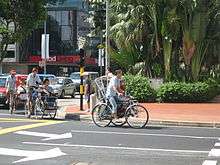
Roads
Singapore pioneered the modern use of toll roads to enter the most congested city centre area with the Singapore Area Licensing Scheme, which has since been replaced with the Electronic Road Pricing, a form of electronic toll collection.
- Total length of expressways: 161 km
- Total length of major arterial roads: 645 km
- Total length of collector roads: 557 km
- Total length of local access roads: 2048 km (as of 2011)[2]
Traffic drives on the left which is typical in Commonwealth countries.
- Cars
As of 2015, there was a total of 957,246 motor vehicles in Singapore, with 519,645 of them being private cars.[3]
Expressways
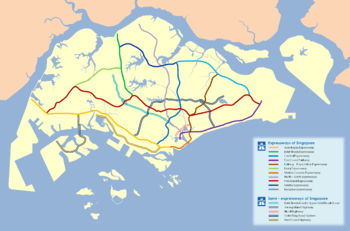
The planning, construction and maintenance of the road network is overseen by the Land Transport Authority (LTA), and this extends to expressways in Singapore. These form key transport arteries between the distinct towns and regional centres as laid out in Singapore's urban planning, with the main purpose of allowing vehicles to travel from satellite towns to the city centre and vice versa in the shortest possible distance. These expressways include:
- Ayer Rajah Expressway (AYE)
- Bukit Timah Expressway (BKE)
- Central Expressway (CTE)
- East Coast Parkway (ECP)
- Marina Coastal Expressway (MCE)
- Kallang–Paya Lebar Expressway (KPE)
- Kranji Expressway (KJE)
- Pan Island Expressway (PIE)
- Seletar Expressway (SLE)
- Tampines Expressway (TPE)
- North-South Expressway (under planning)[4]
The influence of expressways on Singapore's transport policy developed shortly after independence during the history of Singapore because of frequent traffic congestion in the Central district. The aim was to encourage residential development in other parts of the island and give residents in these new "satellite towns" a convenient link between their homes and their workplaces (which were mostly situated around the city centre.)
Cable car
The Singapore Cable Car, plies between Mount Faber on the main island of Singapore and the resort island of Sentosa as an alternative means of accessing that tourist attraction. The cable car system underwent a revamp that was completed in August 2010.
Water transport within Singapore
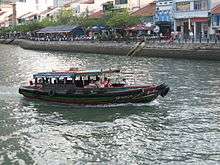
Water transport within the main island is limited to the River Taxi along the Singapore River. The service was introduced in January 2013, with low ridership.[5][6] There are also daily scheduled ferry services from the Marina South Pier to the Southern Islands such as Kusu Island and Saint John's Island.[7]
Public transport
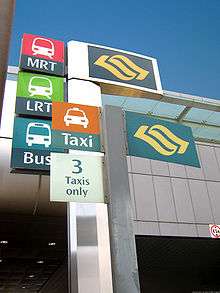
Singapore has one of the most cost-efficient public transport networks in the world, according to a study by London consulting firm Credo.[8] Public transport covers a variety of transport modes such as bus, rail and taxi. This is a result of great emphasis by the Government of Singapore to promote its use over private transport. About 5.308 million trips are made on a daily basis on the public transport system and at least half of its population utilises it daily.
The public transport system is the most important means of transportation to work and school for Singaporeans. About 52.4% of Singaporean residents (excluding foreigners) go to work using public transport according to the Singapore Census of Population 2000, with 41.6% using private transport and the remaining 6.1% not requiring any form of transport. Amongst school-going residents, 41.5% of them go to school by public transport, 24.9% by private transport, and a further 30.1% do not require any form of transport at all.
A slight dip has been noted in the number of Singaporeans and permanent residents using public transport compared to 1990, which had 55.0% and 46.3% of them going to work and to school respectively. The government aims to reverse this trend such that the total average number of commuters on public transport rises above 75% of all trips made.[2]
Buses
%2C_SBS_Transit_(2016-01-03).jpg)
Public Bus transportation:
- Routes: 195 routes (2016)
- Fleet: More than 3,000 buses (2016)
- Routes: 77 routes (2016)
- Fleet: More than 1,400 buses (2016)
- Routes: 26 Routes (2016)
- Fleet: 380 Buses (2016)
- Routes: 25 routes (2016)
- Fleet: 380 buses (2016)
- Go-Ahead Singapore will commence the operation of 24 services in two tranches. 13 bus services will begin on 4 September 2016, while another 11 on 18 September. Another route will be introduced in 2017, and details of the route will be announced closer to the implementation date.
Rail

In 2016, the rail lines present are
MRT/Metro/Subway lines under SMRT:
- North South MRT Line (Red)
- East West MRT Line (Green)
- Circle MRT Line (Yellow)
- Bukit Panjang LRT Line(Light Rapid Transit)(Grey)
MRT/Metro/Subway lines under SBS Transit:
- North East MRT Line (Purple)
- Downtown MRT Line (Blue)
- Sengkang LRT Line (Light Rapid Transit) (Grey)
- Punggol LRT Line (Light Rapid Transit) (Grey)
Sentosa:
Upcoming lines:
- Tuas Link MRT Station (Tuas Link Extension)
- Thomson-East Coast MRT Line
- Circle Line Stage 6 Circle MRT Line
- New Canberra station on North South Line
- Cross Island MRT Line (Under Planning)
- Jurong Region MRT Line
- Downtown Line extension
- North East Line extension
- Kuala Lumpur–Singapore High Speed Rail
Taxis
Taxicabs are a popular form of public transport in the compact sovereign city-state of Singapore, with fares considered relatively low compared to those in most cities in developed countries. As of December 2014, the total taxi fleet in Singapore is 28,736 taxis, operated by six taxi companies and 178 independent drivers. Taxis may be flagged down at any time of the day along any public road outside of the Central Business District (CBD).
_1.7_CRDi_sedan%2C_Comfort_Taxi_(2016-01-03).jpg)
Public transport regulations
The public transport system is regulated by the Land Transport Authority, which oversees the three main modes of public transportation. Fare regulation and bus service standards are under the purview of an independent body, the Public Transport Council, while TransitLink, established by SBS Transit, SMRT Trains and SMRT Buses, helps to create an integrated multi-modal system with a common fare-payment mode, information platform, and a physical network without duplication of services.
The policies of the Land Transport Authority are meant to encourage the use of public transport in Singapore. The key aims are to provide an incentive to reside away from the Central district, as well as to reduce air pollution. Singapore has a Mass Rapid Transit (MRT) and Light Rail Transit (LRT) rail system consisting of five lines. There is also a system of bus routes throughout the island, most of which have air conditioning units installed due to Singapore's tropical climate. Buses without air conditioning installed are gradually being phased out. A contactless smart card called the EZ-Link card is used to pay bus and MRT fares.
Public transport for tourists
Launched in December 2007 by Land Transport Authority, Singapore Tourism Board and EZ-Link, the Singapore Tourist Pass[9] offers unlimited travel for tourists to Singapore on Singapore's public transport system. For $8 a day, tourists can take any number of rides on buses and trains operated by SBS Transit, SMRT Buses and SMRT Trains. Certain buses like Night Rider are not applicable. The Singapore Tourist Pass is available at selected MRT stations.
International transport links
Singapore is well connected to other countries via land, air and sea.
Land
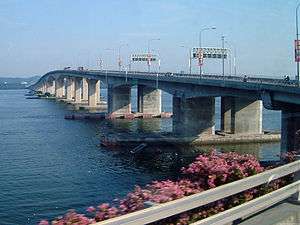
Singapore has two land links to Malaysia. The Johor-Singapore Causeway, built in the 1920s to connect Johor Bahru in Johor, Malaysia to Woodlands in Singapore, carries a road and a railway line. The Tuas Second Link, a bridge further west, was completed in 1996 and links Tuas in Singapore to Tanjung Kupang in Johor.
The international railway line to Malaysia is an extension of the Malaysian rail network operated by Keretapi Tanah Melayu (Malayan Railways). Since 1 July 2011, Woodlands Train Checkpoint serves as the southern terminus of the KTM rail network. Previously, KTM trains terminated at Tanjong Pagar railway station in central Singapore. Two more rail links are being planned: the Kuala Lumpur-Singapore High Speed Rail terminating in Jurong East, and the Johor Bahru-Singapore Rapid Transit System between Woodlands North and Bukit Chagar, Johor Bahru.
Sea

There are boats and ferry services to nearby islands of Malaysia and Indonesia. These services can be found at Changi Ferry Terminal, Changi Point Ferry Terminal, Tanah Merah Ferry Terminal, Singapore Cruise Centre and Marina Bay Cruise Centre Singapore.
The Port of Singapore, run by the port operators PSA International (formerly the Port of Singapore Authority) and Jurong Port, is the world's busiest in terms of shipping tonnage handled 1.04 billion gross tons were handled in the year 2004, crossing the one billion mark for the first time in Singapore's maritime history. Singapore also emerged as the top port in terms of cargo tonnage handled with 393 million tonnes of cargo in the same year, beating the Port of Rotterdam for the first time in the process. In 2006, it handled a total of 448 million tonnes of cargo.[10]
Singapore is ranked second globally in terms of containerised traffic, with 21.3 million Twenty-Foot Equivalent Units (TEUs) handled in 2004,[11] and is also the world's busiest hub for transshipment traffic. Additionally, Singapore is the world's largest bunkering hub, with 23.6 million tonnes sold in 2004.[12]
In 2007, the Port of Singapore is ranked the world's busiest port once again, surpassing Hong Kong and Shanghai.[13] The Port of Singapore is also ranked the Best Seaport in Asia.
| Port | Operator | Type | Berths | Quay length (m) | Quay cranes | Area (m²) | Capacity (kTEUs) |
|---|---|---|---|---|---|---|---|
| Brani (BT) | PSA International | Container | 9 | 31 | 790,000 | ||
| Cosco-PSA (CPT) | Cosco/PSA International | Container | 2 | 720 | 228,000 | >1 million | |
| Jurong | JTC | Multi-Purpose | 23 | 4,486 | 1,200,028 | ||
| Keppel (KT) | PSA International | Container | 14 | 36 | 960,000 | ||
| Pasir Panjang (PPT) | PSA International | Container | 12 | 49 | 1,770,000 | ||
| Pasir Panjang Wharves | PSA International | General | |||||
| Sembawang | PSA International | General | |||||
| Tanjong Pagar (TPT) | PSA International | Container | 8 | 27 | 840,000 |
Air

Singapore aims to be Asia's aviation hub chiefly via the promotion of liberal aviation policies in a bid to encourage airlines to commence and maintain operations there. The aviation industry is regulated by the Civil Aviation Authority of Singapore, a statutory board of the Singapore government under the Ministry of Transport.
An open skies agreement was concluded with the United Kingdom in October 2007 permitting unrestricted services from Singapore by UK carriers. Singapore carriers were allowed to operate domestic UK services as well as services beyond London Heathrow to a number of destinations, including the United States along with Canada.[14]
Airlines
There are six local scheduled service airlines, all of them operating from Singapore Changi Airport, offering scheduled flights to over 70 cities on six continents. The national flag carrier, Singapore Airlines, operates from Changi Airport Terminal 2 and 3. Its subsidiaries, SilkAir and Scoot, operate from Changi Airport Terminal 2.
Singapore's two budget airlines, Jetstar Asia Airways and Valuair, operate from Changi Airport Terminal 1. Only one budget airline, Tiger Airways, chose to operate at the Budget Terminal; other budget airlines have cited various reasons for not shifting operations to the Budget Terminal, including accessibility and ease of transfers to connecting flights.
Tiger Airways Singapore now operates from Changi Airport Terminal 2 due to the demolishment of the Budget Terminal for the future Terminal 4, since 2012.
- Jetstar Asia Airways – founded 2004
- Scoot – founded 2011
- SilkAir – founded 1976
- Singapore Airlines – founded 1937 (as Malayan Airways)
- Tigerair – founded 2003
- Valuair – founded 2004 (merged with Jetstar Asia in 2005, brand retained for certain Jetstar Asia's services)
Airports
Singapore Changi Airport, with its three terminals, is one of the most important air hubs in the region. The international airport is situated at the easternmost tip of the main island, and serves 185 cities in 58 countries.[15] With the recent opening of the third terminal, Changi is now capable of handling 64 million passengers every year.
Seletar Airport is Singapore's first civil aviation airport and is primarily used for private aviation today. The airport also serves limited scheduled commercial flights by Berjaya Air to the Malaysian islands of Tioman Island and Redang Island.
| Airport | ICAO | IATA | Usage | Runway | Length (ft) | Length (m) | Remarks |
|---|---|---|---|---|---|---|---|
| Paya Lebar Air Base | WSAP | QPG | Military | Paved | 12400 | 3800 | Former civilian |
| Seletar Airport | WSSL | XSP | Civilian/Military | Paved | 6023 | 1836 | Mainly non-scheduled flights |
| Sembawang Air Base | WSAG | Military | Paved | 3000 | 914 | ||
| Singapore Changi Airport | WSSS | SIN | Civilian | Paved | 13200 | 4000 | |
| Tengah Air Base | WSAT | TGA | Military | Paved | 8900 | 2713 |
Heliports
References
- ↑ "Study: Singapore's public transport system one of world's most efficient".
- 1 2 "Facts and Figures" (PDF). Land Transport Authority.
- ↑ "Annual Vehicle Statistics 2015: MOTOR VEHICLE POPULATION BY VEHICLE TYPE" (PDF). Land Transport Authority. November 12, 2016. Retrieved November 12, 2016.
- ↑ "Speech by Mr Raymond Lim, Minister for Transport, at visit to Kallang-Paya Lebar expressway, 30 January 2008, 10:15 AM". Singapore Government Media Release. 30 January 2008.
- ↑ "Water taxis to make a splash in Singapore". Telegraph. 27 December 2011. Retrieved 6 April 2014.
- ↑ "Few using water taxis as regular mode of commute". TODAY. 2 August 2013. Retrieved 6 April 2014.
- ↑ "Singapore Island Cruise". islandcruise. Retrieved 6 April 2014.
- ↑ CNN Go 2 June 2014. Retrieved 2016-01-31
- ↑ "The Singapore Tourist Pass". Retrieved 26 March 2008.
- ↑ "Total Cargo (in '000 tons)" (PDF). Maritime and Port Authority of Singapore. Archived from the original (PDF) on 12 June 2007. Retrieved 26 March 2008.
- ↑ Archived 3 October 2008 at the Wayback Machine.
- ↑ "Total Container Throughput (in '000 TEUs)" (PDF). Maritime and Port Authority of Singapore. Archived from the original (PDF) on 12 June 2007. Retrieved 26 March 2008.
- ↑ "Singapore remains world's busiest port". Xinhuanet. 12 January 2006.
- ↑ "Singapore, UK conclude landmark Open Skies Agreement". Channelnewsasia.com. 3 October 2007.
- ↑ "Air Network". changiairport.com. Retrieved 26 March 2008.
External links
| Wikimedia Commons has media related to Transport in Singapore. |
- Ministry of Transport
- Public Transport Council
- Land Transport Authority
- TransitLink
- PublicTransport@SG
- Taxi Singapore and Transport Guide
.svg.png)